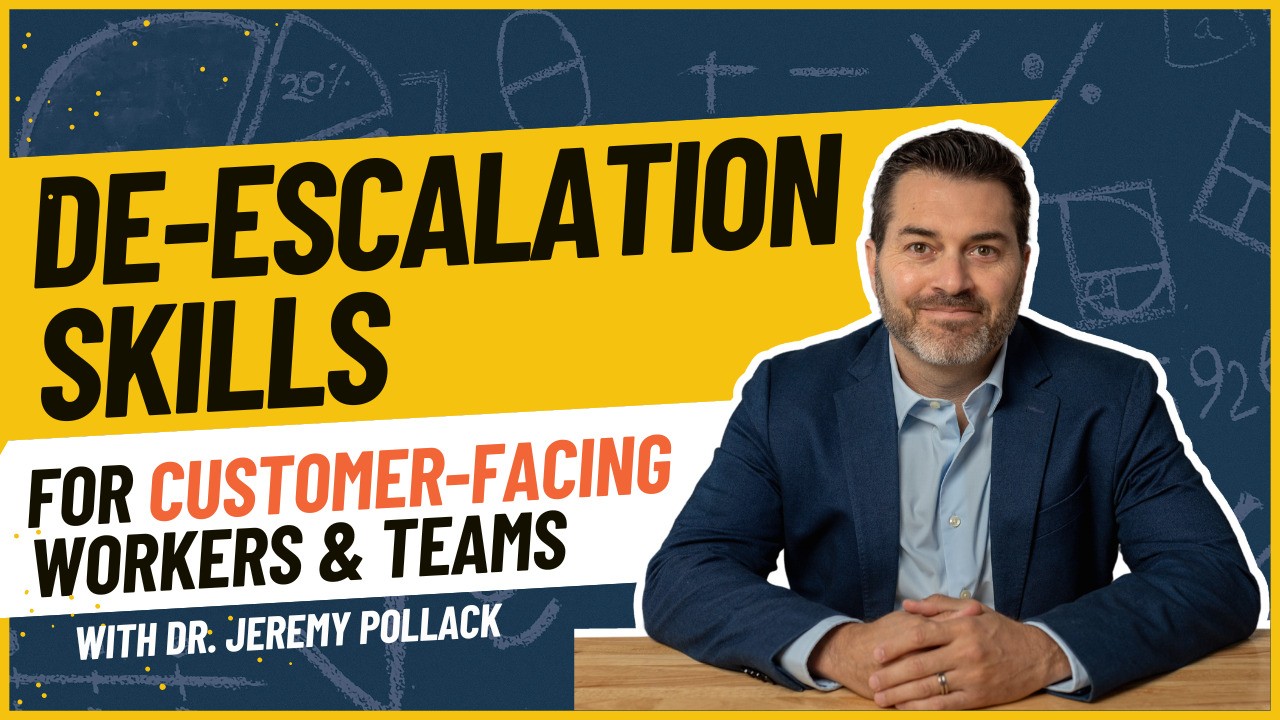
Customer interactions can make or break a business. While positive experiences build loyalty, dealing with angry customers is an inevitable part of the customer service landscape. When emotions run high, situations can escalate quickly, damaging customer relationships and tarnishing a brand’s reputation.
This is where de-escalation becomes a critical skill. Effective de-escalation techniques can calm the storm and provide an opportunity to rebuild trust and improve customer retention.
This blog explores the psychology of anger, common triggers for customer complaints, and proven techniques to manage high-stress scenarios.
Understanding Customer Anger
To effectively handle angry customers, one must first understand the triggers and underlying psychology of anger. Anger is an escalation of frustration, a response to perceived threats to personal values or unmet expectations.
Unresolved anger can evolve into rage, creating damaging ripple effects for both customers and businesses. According to one report, 68% of customers cited unfair treatment as the root of their anger, while 60% mentioned a lack of respect or dignity during service interactions.
Common Triggers of Customer Anger
What triggers customer anger?
1. Repeated Service Failures
Nothing frustrates customers more than unresolved issues. Most angry customers report enduring multiple failed attempts to resolve their concerns before their frustration peaks.
For instance, a case study described a customer who contacted an insurance company 11 times to address a $500 refund. Each time, her issue was dismissed due to a lack of follow-through, leading to a deep sense of helplessness and anger.
Repeated failures signal a lack of competence, pushing frustrated customers to their tipping point.
2. Lack of Communication
When businesses fail to provide updates or leave customers waiting without explanations, they often feel ignored. Silence or vague responses breed distrust. Research confirms that unresolved waiting times are one of the fastest ways to escalate frustration.
3. Disrespectful or Unempathetic Behavior
Service personnel who appear indifferent or dismissive can provoke a strong emotional reaction. Many customers cite disrespect from customer service representatives as a direct trigger for their anger. When customer support agents fail to acknowledge a customer’s value, it can lead to feelings of rejection and resentment.
4. Long Wait Times
Imagine waiting in a queue for 30 minutes, only to be met with inefficiency. Long waits-especially when combined with poor service-are among the most cited causes of customer complaints.
5. Being Passed Between Agents
When customers must repeat their issue multiple times to different agents, their frustration multiplies. Each retelling of the customer’s concerns feels like a step backward instead of progress. This common problem highlights poor internal communication and diminishes trust in the customer support process.
Psychological Underpinnings of Anger
Anger often stems from perceived threats to psychological needs. These include:
- Fairness: Customers expect to be treated equitably. When they feel cheated, their anger can quickly escalate. For instance, a customer being asked to pay additional fees for services they thought were covered will likely feel exploited.
- Control: Losing control over a situation-such as being unable to reach a resolution-can provoke intense frustration.
- Respect: Dismissive or rude behavior from employees can feel like a personal attack, damaging the customer’s sense of dignity and fueling resentment.
Key De-Escalation Techniques
Here are five proven techniques to effectively de-escalate angry customers and turn conflicts into opportunities for resolution.
Active Listening and Empathy
Active listening is the cornerstone of de-escalation. Customers want to feel heard and understood, especially when they are upset. By actively listening, you demonstrate genuine care for their concerns, defusing tension and opening a path for dialogue.
- Example: A customer service agent handling a delivery delay can respond, “I understand how frustrating it is to wait longer than expected. Let me look into this for you immediately.”
- Empathy phrases such as “I hear you” or “I can see how that would be upsetting” can validate a customer’s feelings, reducing their emotional charge.
- Tip: Avoid interrupting or defending your position too soon. When practicing active listening toward customers, allow the customer to express their frustration fully before guiding the conversation toward solutions.
Staying Calm and Composed
Emotions are contagious. A calm demeanor from the agent can have a calming effect on even the most agitated, angry customer. Staying composed requires self-awareness and emotional regulation.
- Strategy: When faced with escalating tension, pause and breathe deeply. Use a steady tone to reassure the customer that their concerns are being taken seriously.
- Example: Instead of reacting defensively to accusations, say, “I am here to help resolve this for you.”
- Maintaining calm also protects the agent from absorbing the customer’s anger, helping them remain professional and focused.
Using Positive Language
The way you frame your response can either escalate or diffuse the situation. Positive, solution-focused language helps reassure the customer that their issue is solvable. For instance, you can deliver bad news in a positive way by focusing on what can be done rather than what cannot.
- Example: Replace “We cannot do that” with “Here is what I can do to help you.” This subtle shift not only avoids a negative tone but also keeps the conversation constructive.
- Tip: Acknowledge the issue with phrases like “Thank you for bringing this to our attention.” Such statements signal appreciation for the customer’s frustration, even if the problem is not immediately fixable.
Setting Clear Boundaries
While empathy is essential, it is also important to set boundaries in extreme cases, especially when a customer’s anger turns abusive. Establishing limits respectfully ensures that the interaction remains productive.
- Example: “I want to resolve this for you, but I need us to maintain a respectful dialogue.”
- Tip: If necessary, involve a supervisor to de-escalate highly aggressive situations while keeping yourself safe.
Offering Solutions
Angry customers want one thing above all: resolution. Providing clear, actionable solutions can diffuse even the most tense interactions. By involving the customer in choosing their preferred solution, you restore their sense of control.
- Example: “Would you prefer a replacement product or a refund?” Providing options reinforces your commitment to resolving issues while empowering them to make decisions.
- Highlight: Personalized solutions demonstrate your dedication to exceptional customer service, leaving the customer feeling valued.

The Role of Communication Skills
In customer service, communication is the bridge between conflict and resolution. The way a customer service representative interacts can determine whether a situation escalates or de-escalates.
Effective communication builds trust, fosters understanding, and provides the clarity needed to resolve issues.
Verbal vs. Non-Verbal Communication
Words matter, but so do unspoken cues. Verbal communication involves the language and tone agents use to address customer complaints, while non-verbal communication includes body language, facial expressions, and gestures. Both play a significant role in de-escalation.
Verbal Communication
The choice of words can either soothe or inflame a tense situation. Phrases like “I understand your frustration” or “Let us work together to fix this” show empathy and a willingness to help.
In contrast, dismissive remarks such as “That is not our policy” can make customers feel ignored or undervalued. Using positive language helps redirect the focus toward solutions.
For instance, to apply verbal de-escalation techniques, do the following:
- Instead of saying, “I do not know,” say, “I will find out for you.”
- Replace “That is not possible” with “Let me see what we can do to help.”
Non-Verbal Communication
Non-verbal cues often speak louder than words. A calm and open posture, steady eye contact, and friendly expression can convey attentiveness and care. On the other hand, crossed arms, frowning, or avoiding eye contact may signal disinterest, even if unintended.
According to Albert Mehrabian, non-verbal signals account for up to 55% of communication impact, making them critical during tense situations.
The Importance of Tone and Body Language
Tone sets the mood for the conversation. A calm, steady tone can de-escalate tension, while an abrupt or impatient tone can exacerbate it. Agents should aim to sound reassuring and professional, even when dealing with angry customer calls.
Similarly, body language complements verbal communication. For example:
- Leaning slightly forward signals engagement.
- A nod shows understanding and agreement.
- Maintaining a neutral yet approachable expression ensures the customer feels heard without further provoking their emotions.
Importance of Mindfulness
Mindfulness is the art of being present and fully engaged in the moment without judgment. For customer service representatives, practicing mindfulness can be a game-changer when dealing with challenging situations.
By cultivating awareness and emotional regulation, agents can remain calm under pressure and navigate high-stress interactions with confidence.
Practicing Mindfulness to Maintain Calmness
In the heat of a tense conversation, emotions can easily spiral out of control. Mindfulness helps agents stay grounded, enabling them to respond thoughtfully rather than react impulsively. A mindful approach creates a sense of control and professionalism, even during angry customer calls.
Benefits of mindfulness in customer service include:
- Improved focus and clarity, ensuring the agent fully understands the customer’s concerns.
- Enhanced emotional regulation, reducing the likelihood of defensive or reactive responses.
- A calmer demeanor, which reassures the customer and promotes respectful conversations.
Mindfulness Techniques for Customer Service Representatives
Here are practical mindfulness techniques that customer service agents can incorporate into their daily routines:
- Deep Breathing Exercises: Deep breathing is one of the quickest ways to reduce stress. Before answering a call, agents can take three slow, deep breaths to center themselves. During a difficult conversation, pausing to take a breath can prevent reactive responses.
- Body Scanning: Body scanning involves bringing awareness to different parts of the body to release tension. For example, an agent might notice they are clenching their jaw or tightening their shoulders during a call. Consciously relaxing these areas can improve their posture and tone.
- Mindful Listening: Mindful listening requires customer service agents to focus entirely on the customer’s words without forming judgments or planning their response prematurely. This technique ensures the customer feels fully heard and understood, which is critical when actively listening to their frustrations.
- Visualization: Visualization techniques, such as imagining a positive outcome for the interaction, can help agents maintain a constructive mindset. For example, envisioning the customer leaving the call satisfied can motivate agents to approach the conversation with empathy and patience.
- Post-Interaction Reflection: After handling a particularly tough call, agents can take a moment to reflect on what went well and what could be improved. This practice fosters continuous growth and reinforces the value of mindfulness in handling challenging situations.
Conflict Resolution Strategies
De-escalating anger is just the first step, and resolving the conflict is what ultimately restores the customer’s trust. Effective conflict resolution requires identifying the root cause of the issue and taking actionable steps to address it. When done correctly, it can turn a frustrated customer into a loyal advocate.
Identifying the Root Cause of the Conflict
Understanding the real issue behind a customer’s frustration is essential. Often, what appears to be the problem on the surface-such as a delayed shipment-is a symptom of deeper concerns, like a lack of communication or unmet expectations.
Steps to uncover the root cause:
- Ask Open-Ended Questions: Encourage the customer to share their experience in detail. Questions like, “Can you walk me through what happened?” or “What outcome would you like to see?” provide valuable insights into their expectations and pain points.
- Listen Without Interrupting: Let the customer fully express their concerns before responding. Interrupting can make them feel dismissed, escalating their frustration.
- Clarify and Confirm: Paraphrase the customer’s concerns to ensure mutual understanding. For example: “If I understand correctly, you are upset because the replacement product has not arrived on time. Is that correct?”
- Check for Patterns: Consider whether this issue is part of a recurring problem. Identifying trends can help prevent future complaints and improve customer experience.
Steps to Mediate and Resolve Conflicts
Once the root cause is identified, the focus shifts to resolution. Below are actionable steps to mediate conflicts effectively:
- Acknowledge the Issue: Begin by validating the customer’s feelings. A simple acknowledgment, such as “I understand this has been frustrating for you,” can diffuse tension and pave the way for resolution.
- Apologize Sincerely: A heartfelt apology can go a long way in mending customer relationships. Be specific about what you are apologizing for, and avoid generic statements. For instance, “I am sorry for the delay in addressing your refund request” feels more genuine than “We are sorry for the inconvenience.”
- Offer Clear Solutions: Provide the customer with actionable options. For example, “We can expedite your delivery at no additional cost or issue a full refund. Which would you prefer?” This approach empowers the customer and demonstrates your commitment to resolving their concerns.
- Follow Through Promptly: Ensure that the promised solution is implemented without delay. Failing to follow through can reignite the conflict, undoing any progress made.
- Document the Interaction: Record the details of the resolution for future reference. This step prevents the same issue from recurring and provides valuable data for improving internal processes.
Training and Support From Peaceful Leaders Academy
At Peaceful Leaders Academy, we offer a range of programs designed to equip a customer service team with the tools they need to handle angry customers effectively and foster a harmonious workplace.

We provide a variety of online, self-paced courses tailored to the needs of professionals:
- De-Escalation for Customer Service: This workshop teaches de-escalation techniques specifically for customer-facing employees. Participants learn to manage and defuse angry customer calls effectively, boosting customer satisfaction and loyalty.
- Conflict Resolution Training for Employees: This program improves problem-solving and emotional intelligence, fostering respect and empathy among customer support team members to create a positive workplace culture.
- Certified Peaceful Leader™ Certification: For those looking to enhance their leadership skills, this certification program focuses on the principles and competencies of peaceful leadership through practical exercises.
Let us help your team transform challenging customer interactions into opportunities to build trust and loyalty. Contact us to explore how our training programs can empower your organization.



